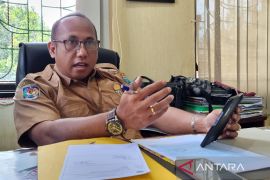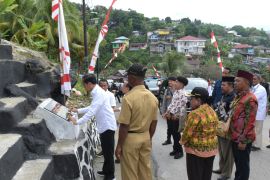In the past, many traditional fishermen were fishing using bombs. Now, their number has decreased significantly."Jakarta (ANTARA News) - Known for its intact marine ecosystem, West Papua Provinces district of Raja Ampat has been actively promoted worldwide in attracting tourists over the last five years.
Literally meaning "Four Kings," Raja Ampat has been derived from a local myth and has one of the most beautiful marine panoramas in the world, and is located in the Coral Triangle area, the heart of the worlds coral reef biodiversity.
The archipelago comprises around 1.7 thousand isles and encompasses more than 9.8 million acres of land and sea off the northwestern tip of West Papua Province. It has four major islands--Waigeo, Salawati, Batanta, and Misool--which are home to ancient rock paintings.
The center of Raja Ampat administration is located in the city of Waisai on Waigeo Island.
Raja Ampat has a marine conservation area measuring about 1.2 million hectares. The best preserved coral reefs exist in Dampier Strait located between Waigeo and Batanta islands.
In the southern part of Raja Ampat, Misool Island has endemic coral reefs.
It has 75 percent of the worlds coral species, 10 times the number of corals in Caribbean; five species of rare turtles; 57 species of mantis shrimps; 13 species of marine mammals; and 27 species of rare fish.
In addition, the island consists of 60 varieties of crayfish, 699 types of soft animals or species of mollusks, comprising 530 species of snails (Gastropoda), 159 species of shells (bivalva), two species of Scaphopoda, five species of squid (Cephalopoda), and three Chiton species.
Based on various studies by world natural conservation agencies, such as Conservation International and Nature Conservancy, Raja Ampat waters are estimated to be home to 1,397 fish species. The waters of Raja Ampat are also called the "Fish Capital of the World."
The isles of Raja Ampat were visited by several European explorers in the nineteenth century. In 1860, the renowned British researcher Sir Alfred Wallace had spent three months in Waigeo studying birds and insects.
Raja Ampat is often called "Heaven on Earth," "Miracle of Papua," "Underwater Paradise on Earth," or "Real Wonder of the World" for its mesmerizing natural scenery.
It has been recognized as one of the worlds 10 most beautiful diving sites and rated number one for its rich diversity of marine flora and fauna.
The Indonesian government as well as the West Papua provincial administration have determined to promote Raja Ampat as an exclusive world tourist destination.
Head of Raja Ampats tourism office Hasnawati recently said in Waisai that the number of foreign and domestic tourists visiting the district has continued to increase every year.
She noted that in 2010, only 3,855 tourists had visited Raja Ampat, but due to intensive promotion the number had sharply increased to 11,130 in 2013.
"Currently, the Raja Ampat district government has set itself a target to attract 20,000 tourists, and we believe the target can be achieved following the international marine event, Sail Raja Ampat," Hasnawati remarked.
Sail Raja Ampat themed "Building the Maritime, Bringing Raja Ampat to World Tourism" was held from August 17 to 24, 2014, and participated in by a number of yachts from Singapore and Australia.
Sail Raja Ampat is the sixth event of the Sail series, following Sail Bunaken in 2009, Sail Banda in 2010, Sail Wakatobi-Belitung in 2011, Sail Morotai in 2012, and Sail Komodo in 2013.
Minister of Maritime Affairs and Fisheries Minister Sharif C. Sutardjo has said Sail Raja Ampat 2014 is dedicated to the development of ecotourism in a region that has been proposed as a World Heritage Site by the government of Indonesia.
"The Sail series aims at increasing the regional economy development on the island and remote areas, particularly through the marine tourism sector," the minister explained.
Coral Reef Coverage
Raja Ampat has two marine sanctuaries--Raja Ampat and Waigeo. The sanctuaries have 1,074 species of coral reefs, including 537 hard corals, and 1,246 species of fish, including 889 species of coral fish.
The waters are divided into four zones: core, utilization, sustainable fishery, and public. The core zone is for researches and studies, the utilization zone is for tourism, the sustainable fishery zone is for traditional fishermen, and the public zone is for local community.
The condition of Raja Ampats coral reefs is still sound. The coverage of coral reefs in Raja Ampat is between 60 and 70 percent, which is categorized as high.
To maintain its reputation as "Heaven on Earth," Raja Ampat must preserve its marine ecosystem, particularly the beautiful and colorful coral reefs.
In line with the Tomolol Declaration issued in 2003, every stakeholder in Raja Ampat has agreed to conserve and manage marine resources sustainably.
The Raja Ampat district administration has established a public supervision group to protect and conserve its coral reefs.
The group is expected to promote a sustainable coral reef preservation program involving the local community.
"Local fishermen, who used to practice destructive fishing practices, have been persuaded to help protect the coral reefs by joining the public supervision group. They also assist in patrolling the surrounding waters," Syafri Tuhurea of the Raja Ampat maritime and fishery office stated in Waisai on August 25, 2014.
The Raja Ampat district administration has been carrying out public awareness campaigns on coral reef conservation over the last five years, he noted.
The public have been made to realize that the marine ecosystem not only belonged to the current generation, but to the future generation as well, and therefore it should be protected and preserved.
Now, public awareness of coral reef conservation in Raja Ampat District has improved, he said.
"In the past, many traditional fishermen were fishing using bombs. Now, their number has decreased significantly," Syafri Tuhurea claimed.
The local fishermen have stopped practicing such fishing methods, but those from other regions sometimes illegally fish in the waters of Raja Ampat using bombs, he said.
"The poachers are driven away if they are spotted by the local fishermen. They, however, usually sneak out when the local fishermen and officers are not around," Syafri pointed out.
Besides poaching, however, development activities such as airport and hotel constructions in Raja Ampat District also have the potential of damaging environment, Dani Dasa Permana, head of the Raja Ampat conservation area working unit of the maritime affairs and fisheries office, said in Waisai, on August 26, 2014.
"Various development activities, such as construction of airport, houses, resorts, and hotels on Waigeo island, are not yet environmentally friendly. Trees are being cut off completely," he said, adding that when it rains, thick mud flows into the sea damaging coral reefs.
Illegal fishing activities alone do not cause damage to coral reefs in Raja Ampat waters. Development activities in land also have potential to harm coral reefs, he said.
"When patrolling the waters off West Waigeo, Misool, and Kofiau islands, we nabbed some Buton fishermen poaching by using bombs in the areas," he added.
(T.F001/INE/KR-BSR/A014)
Reporter: Fardah
Editor: Priyambodo RH
Copyright © ANTARA 2014












